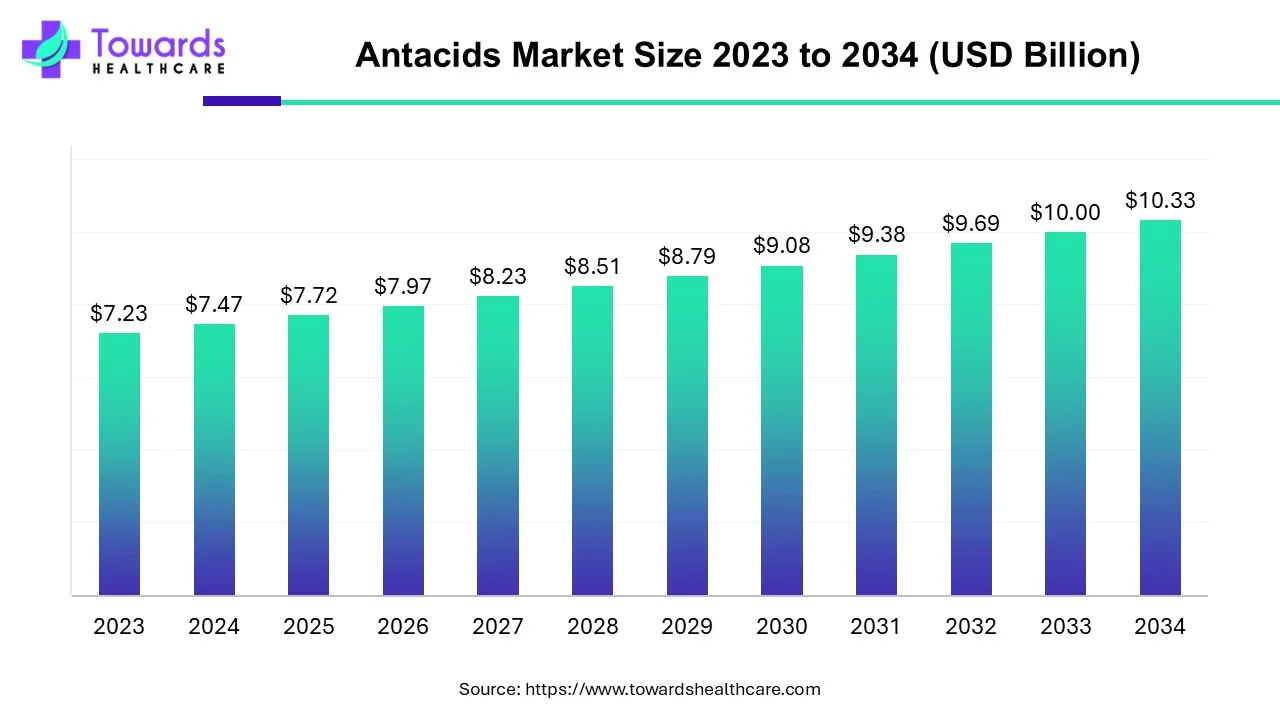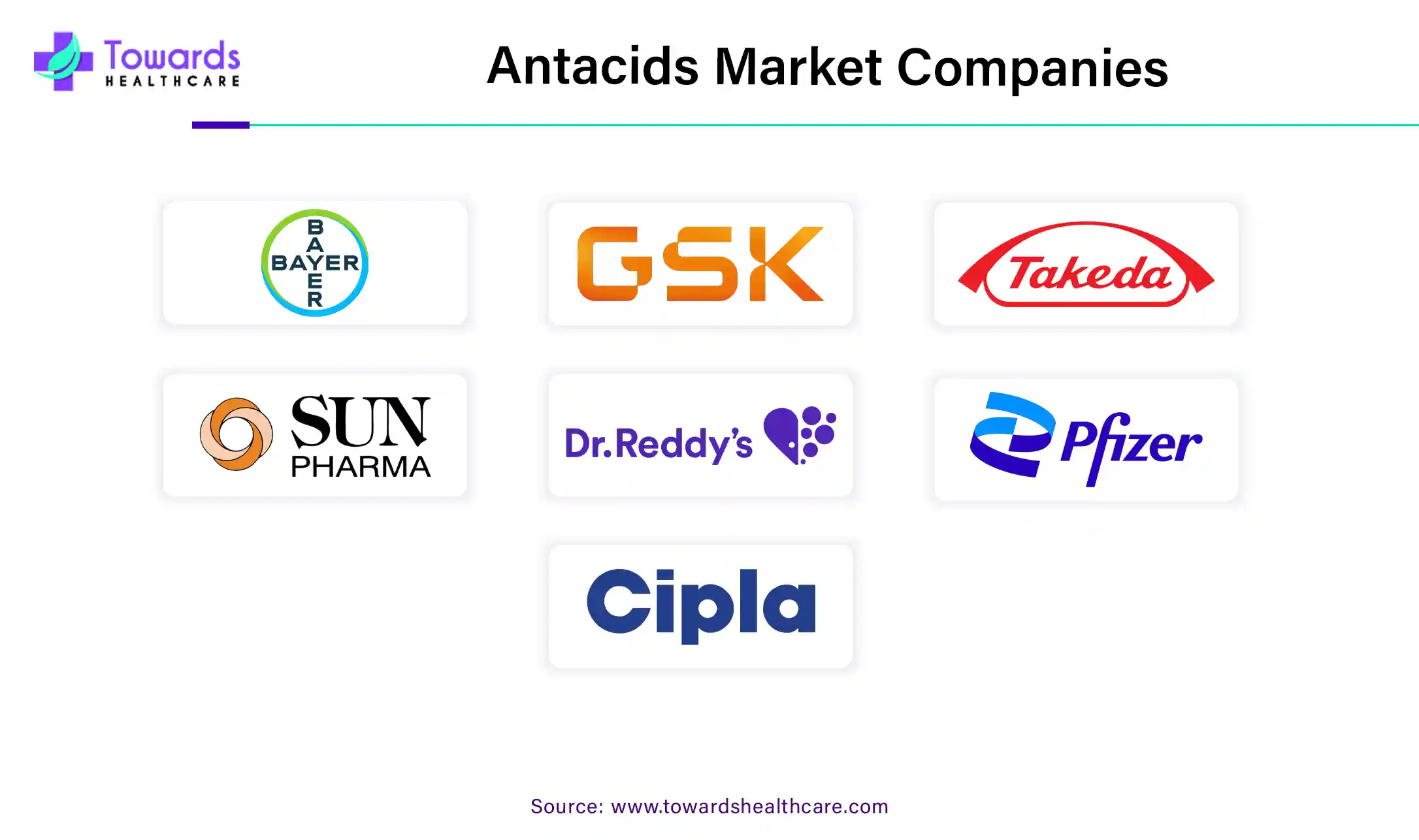January 2025


Principal Consultant

Reviewed By
The global antacids market size is calculated at USD 7.47 billion in 2024 and is expected to be worth USD 10.33 billion by 2034, expanding at a CAGR of 3.30% from 2024 to 2034, as a result of the rising prevalence of GERD and ease of access and improved availability of OTC medicines.

The Surge in Heartburn and Gastroesophageal Reflux Disease Cases in 2022 Propels the Global Antacid Market to New Heights, with Approximately 784 Million Individuals Affected
Antacids are medications that neutralize stomach acid to relieve heartburn and indigestion. They can be purchased over-the-counter in liquid or chewable tablet form. Antacids also treat related conditions like acid reflux and stomach ulcers by reducing stomach acid. Their widespread worldwide use attests to their effectiveness and safety. Measuring buffering and Antacid Neutralizing Capacities (ANC) is essential for clinical efficacy and quality control and may raise consumer awareness. Despite their advantages, given their expanding worldwide market, care must be taken to avoid any potential adverse effects or drug interactions.
Consumers around the world widely purchase antacids, a popular class of over-the-counter (OTC) medications, to relieve the symptoms of acid reflux and heartburn. This has resulted in significant spending that has exceeded billions of dollars. These over-the-counter treatments provide symptomatic relief for conditions like GERD, upset stomach, and hyperacidity. They inhibit the proteolytic enzyme pepsin and neutralize high hydrochloric acid in the gastric juice.
Notably, some research indicates that some antacids may be taken safely while pregnant because of their localized rather than systemic effects. Apart from their medicinal value, antacids have seen significant growth in the market. The prevalence of acid-related digestive problems is rising, and the number of people seeking relief is growing, which supports market growth. Antacids' widespread use is further supported by their over-the-counter availability, making them easily accessible to the global audience.
Additionally, the rise of OTC antacids has played a pivotal role in expanding the Global Market. The convenience of obtaining this medication without a prescription has contributed to its popularity and widespread use. This accessibility not only caters to the immediate relief sought by consumers but also propels the overall growth of the antacid market globally.
For Instance,
The integration of artificial intelligence (AI) into the antacids market is set to drive significant growth and innovation. AI technologies can streamline research and development by analyzing vast datasets to identify new active ingredients and optimize formulations for improved efficacy and reduced side effects. This capability accelerates product development cycles, allowing companies to bring new and enhanced antacid products to market faster.
AI also enables personalized medicine approaches in the antacids sector. By analyzing individual patient data, AI can help in tailoring antacid solutions to specific needs, enhancing treatment effectiveness and patient satisfaction. Additionally, AI-driven predictive analytics can forecast market trends, consumer preferences, and potential market shifts, enabling companies to make informed strategic decisions.
Furthermore, AI enhances manufacturing processes through automation and quality control. Advanced algorithms can monitor production lines in real time, ensuring consistency and high quality while reducing operational costs.
Lifestyle Changes and Remote Work, and Consequently Notable Rises in Unfit Eating Habits during Lockdown During home isolation, several unhealthy eating behaviors showed statistical significance (P<0.001). This includes a rise in the number of meals eaten, occurrences of binge eating, an increase in snacking, and a higher frequency of eating unhealthy foods that result in the treatment of stomach-related issues like GERD, gastric ulcers, and heartburn. Demand for antacids has risen.
For Instance,
Increased gastrointestinal symptoms, modified eating habits, and lifestyle changes added to the demand for antacids. The increase in antacid consumption is a sign of a growing market, highlighting the importance of COVID-19-related factors in influencing people's health-related decisions and fueling the antacid market's expansion.
GERD (Gastroesophageal reflux disease) is a persistent gastrointestinal illness in which gastric contents reflux into the oesophagus. With a prevalence of 20%, it ranks among the most frequently reported digestive diseases in the United States.
In 2021, GERD Awareness Week, the Esophagal Cancer Research Foundation published that Esophageal Cancer has increased during the last 40 years by more than 733%. The rise is attributed to factors like dietary habits and lifestyle changes. Consequently, the antacid market has grown to meet the increasing demand for treating the symptoms of acid reflux.
During the pregnancy, many women experience gastroesophageal reflux disease, with symptoms like heartburn and acid refluxes. GER is quite common in pregnant women.
The study was carried out at Chennai's Global Hospital. This prospective hospital-based study included 64 pregnant women in their first trimester who visited the antenatal clinic. They were interviewed about their dietary habits and GER symptoms, and they followed up with the women until term and delivery. The study's findings showed that 50 women (83.4%) experienced heartburn or Regurgitation during their pregnancy. 20% of the women had heartburn in the first trimester, 6% in the second, and 2% in the third trimester. Twenty-five (41.7%) of the women experience regurgitation, 24 (60%) do so in the second trimester and 14 (23.3%) in the third trimester.

Generally, antacids containing magnesium, calcium, and aluminium are safe, but higher doses are not suggested. Because they carry a risk of fluid overload and metabolic alkalosis, pregnant women should avoid taking any antacids that contain sodium bicarbonate. Of particular note is the rise in popularity of antacids on the worldwide market.
In 2019, As per the reports of the United Nations World Ageing, Globally, there were about 703 million individuals 65 years of age or older. By 2050, it's predicted to reach 1.5 billion. The proportion of people 65 and older worldwide grew from 6% in 1990 to 9% in 2019, and nearly 65% of the elderly population suffers from acid reflux. The market is given an opportunity as a result.
Naturally, the secretion of stomach acid declines with age. Older people are more susceptible to conditions that might profit from antacid use due to this reduction, which can cause digestive problems like reflux of acid, heartburn, and indigestion.
The digestive system may alter with age, slowing down certain digestive functions, among other things. This may worsen the situation by causing more stomach acid, requiring antacids to balance the excess acidity.
The digestive system may alter with age, slowing down certain digestive functions, among other things. A build-up of excessive acidity may result from this. Antacid products will be needed as the world's population ages, and age-related digestive problems become more common. An increasing number of individuals are looking for these products as a symptomatic or preventive measure due to increasing knowledge of gastrointestinal health and antacids' role in controlling common gastrointestinal issues.
The combination of age-related physiological changes and behavioural and societal factors, like changing lifestyles and older people, has increased the demand for antacids worldwide. The ease of accessing over-the-counter options and growing knowledge of the benefits of antacids for digestive health further bolster this demand.
The present study was conducted at the Athens Medical Center's Scientific Committee, which approved the study's ethical application, and it was conducted there in the Department of General, Laparoscopic, Bariatric, and Robotics from October 2019 to March 2020. Data from 144 patients who had surgery between 2009 and 2020 to treat GERD symptoms were gathered for the analysis.
The intensity of gastroesophageal reflux symptoms before surgery was stratified by age group(under 55 years or above 55 years). The intensity of Heartburn was ranked from 0(no symptom)-5(high intensity). Intensity symptom scores that differ in statistical significance (P<0.05) within an age group.

In 2022, the National Institute of Health report shows that globally, approximately 784 million individuals suffered from recurrent heartburn, also known as gastroesophageal reflux disorder (GERD).
Responsible Factors:
A new development in managing gastrointestinal health is using personalized strategies that consider individual responses to dietary and lifestyle interventions and gut microbiota composition. In this context, precision medicine tries to provide more effective results by customizing treatments for particular gastrointestinal conditions. Products like probiotics, dietary supplements and lifestyle changes are some of the factors that have contributed to the fall in the worldwide antacid market. Traditional antacids are being replaced by more preventive and holistic approaches, which consumers demand.
For Instance,
Additionally, Pharmaceutical developments have impacted the market for traditional antacids by enabling the creation of more specialized and durable remedies. Furthermore, consumers are exploring alternative therapies due to growing interest in natural and holistic approaches to GI Health, which has led to a decline in antacid sales. This change indicates a more significant movement in healthcare toward holistic, long-term wellness approaches that prioritize prevention over symptom treatment.
Continued growth of e-commerce is expected, with online providers leveraging technology for improved customer experiences. Retail and hospital pharmacies may provide specialized services and consultations to differentiate themselves. The retail, hospital, and online channels offer to the overall growth of the antacid market, providing consumers with diverse options for managing acid-related issues.
By type, the tablets segment held a dominant presence in the market in 2023. Tablets are the most preferred route of administration due to their ease of use and affordability. The demand increases due to the availability of different types of tables such as fast-releasing tablets to speed up their action. The use of tablets increases patient medication adherence. Out of all the types of routes of administration, tablets are widely consumed.
By type, the liquid segment will gain a significant share of the market over the studied period. Liquid formulations are easier to consume by the patients, especially pediatric and geriatric patients. Liquids also have faster action compared to solid orals.
By end-use, the retail pharmacy segment led the global market in 2023. The segmental growth is attributed to the availability of generic and over-the-counter (OTC) medications, special discounts, and the presence of trained professionals. Some retail pharmacies also offer 24x7 home delivery of medicines.
By end-use, the online pharmacy segment is anticipated to grow with the highest CAGR in the market during the studied years. The rapidly expanding e-commerce sector and facility to order medicines at the comfort of patients’ homes boost the segment’s growth. The same-day delivery facility and special discounts also augment the segment.
The North America region dominated the Global Antacid Market. High disposable income, an ageing population, and a well-established Healthcare system and Infrastructure are all responsible for this. It's also expected that a rise in digestive disorders will play a role.
For Instance,

Asia Pacific is expected to have the fastest-growing market due to several factors, including a high number of unmet clinical needs, efficient treatment options, rising disposable income, and consumer awareness of the availability of these products. In addition, the market is expected to grow during the projected period due to the presence of significant players like Takeda Pharmaceutical Company Ltd., Sun Pharmaceutical Industries Ltd., and Dr Reddy's Laboratories Ltd. Its growth is anticipated to be accelerated by expanding market players' investments and improving healthcare arrangement.
To strategically expand within the global antacid market, meticulous market research is imperative for discerning prevailing trends and understanding consumer preferences. This foundational knowledge is pivotal for customised products to meet evolving demands effectively. The development of inventive antacid formulations distinguishes a company from competitors and addresses specific consumer needs, potentially fostering brand loyalty. It is critical to make wise investments in encompassing marketing strategies. To achieve this, creating captivating stories, using various media, and launching focused advertising is necessary.
In today's business environment, having a solid online presence is essential. Use social media marketing, digital platform for e-commerce, and content creation to reach a wider audience. In addition to increasing visibility, this encourages deep and fruitful customer interaction. By integrating these elements into a comprehensive business strategy, a company can position itself strategically for growth in the competitive global antacid market. In August 2022, it launched and approved multiple new tablets for lower stomach acid, which may further accelerate market expansion. Patients with blood cancer experienced less acid reflux thanks to a new tablet formulation approved by AstraZeneca. As the number of cancer diagnoses rises yearly, it is anticipated that the need for intervention in cancer patients will further accelerate market growth.
Sanjeev Jain, Managing Director, Akums Drugs & Pharmaceuticals Ltd. commented on the launch of its innovative antacid formulation in the Indian market that the increasing prevalence of GERD and its complications require advanced treatment options. He said that their new product offers a unique solution by both forming a protective layer and neutralizing stomach acid.

By Formulation Type
By Distribution Channel
By Region
January 2025
December 2024
December 2024
December 2024